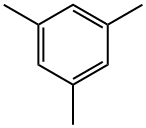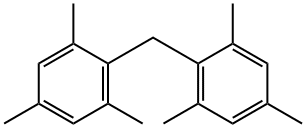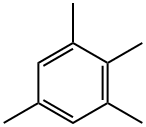Mesitylene
- CAS No.
- 108-67-8
- Chemical Name:
- Mesitylene
- Synonyms
- 1,3,5-TRIMETHYLBENZENE;1,3,5-trimethylbenzene (mesitylene);Fleet-X;1.3.5-TriMethy;Trimethylbenzol;1,3,5-Trimethylbenze;sym-Trimethylbenzene;1,3,5-Trimethylbenzene Standard;NSC 9273;Mesitylen
- CBNumber:
- CB5852758
- Molecular Formula:
- C9H12
- Molecular Weight:
- 120.19
- MDL Number:
- MFCD00008538
- MOL File:
- 108-67-8.mol
- MSDS File:
- SDS
| Melting point | -45 °C |
|---|---|
| Boiling point | 163-166 °C(lit.) |
| Density | 0.864 g/mL at 25 °C(lit.) |
| vapor density | 4.1 (vs air) |
| vapor pressure | 14 mm Hg ( 55 °C) |
| refractive index |
n |
| Flash point | 112 °F |
| storage temp. | 2-8°C |
| solubility | Miscible with alcohol, benzene, ether (Windholz et al., 1983), and trimethylbenzene isomers. |
| form | Liquid |
| pka | >14 (Schwarzenbach et al., 1993) |
| color | Clear colorless |
| explosive limit | 0.88-6.1%, 100°F |
| Odor Threshold | 0.17ppm |
| Water Solubility | 2.9 g/L (20 ºC) |
| Merck | 14,5907 |
| BRN | 906806 |
| Henry's Law Constant | 4.03, 4.60, 5.71, 6.73, and 9.63 at 10, 15, 20, 25, and 30 °C, respectively (EPICS, Ashworth et al.,1988) |
| Exposure limits | NIOSH REL: TWA 25 ppm (125 mg/m3); ACGIH TLV: TWA for mixed isomers 25 ppm (adopted). |
| Dielectric constant | 3.4(Ambient) |
| Stability | Stable. Combustible. Incompatible with strong oxidizing agents. |
| InChIKey | AUHZEENZYGFFBQ-UHFFFAOYSA-N |
| LogP | 3.42 at 20℃ |
| CAS DataBase Reference | 108-67-8(CAS DataBase Reference) |
| EWG's Food Scores | 1 |
| FDA UNII | 887L18KQ6X |
| NIST Chemistry Reference | Benzene, 1,3,5-trimethyl-(108-67-8) |
| EPA Substance Registry System | 1,3,5-Trimethylbenzene (108-67-8) |
SAFETY
Risk and Safety Statements
| Symbol(GHS) |     GHS02,GHS07,GHS08,GHS09 |
|||||||||
|---|---|---|---|---|---|---|---|---|---|---|
| Signal word | Danger | |||||||||
| Hazard statements | H226-H304-H315-H332-H335-H411 | |||||||||
| Precautionary statements | P210-P273-P301+P310-P303+P361+P353-P304+P340+P312-P331 | |||||||||
| Hazard Codes | Xi,N,F,T | |||||||||
| Risk Statements | 10-37-51/53-39/23/24/25-23/24/25-11-37/38 | |||||||||
| Safety Statements | 61-45-36/37-16-7 | |||||||||
| RIDADR | UN 2325 3/PG 3 | |||||||||
| WGK Germany | 2 | |||||||||
| RTECS | OX6825000 | |||||||||
| F | 10 | |||||||||
| Autoignition Temperature | 1022 °F | |||||||||
| Hazard Note | Irritant/Flammable | |||||||||
| TSCA | Yes | |||||||||
| HazardClass | 3 | |||||||||
| PackingGroup | III | |||||||||
| HS Code | 29029080 | |||||||||
| Toxicity | LD50 (inhalation) for rats 24 g/m3/4-h (quoted, RTECS, 1985). | |||||||||
| NFPA 704 |
|
Mesitylene price More Price(39)
| Manufacturer | Product number | Product description | CAS number | Packaging | Price | Updated | Buy |
|---|---|---|---|---|---|---|---|
| Sigma-Aldrich | 8.05890 | Mesitylene Technipur?, for synthesis | 108-67-8 | 1L | $73.6 | 2024-03-01 | Buy |
| Sigma-Aldrich | 8.05890 | Mesitylene Technipur?, for synthesis | 108-67-8 | 165KG | $4870 | 2024-03-01 | Buy |
| Sigma-Aldrich | 63908 | Mesitylene analytical standard | 108-67-8 | 5ml | $242 | 2024-03-01 | Buy |
| Sigma-Aldrich | 61927 | Mesitylene certified reference material, TraceCERT | 108-67-8 | 100mg | $112 | 2024-03-01 | Buy |
| Sigma-Aldrich | 41103 | 1,3,5-Trimethylbenzene solution certified reference material, 5000?μg/mL in methanol | 108-67-8 | 1mL | $61.3 | 2024-03-01 | Buy |
Mesitylene Chemical Properties,Uses,Production
Outline
The molecular structure of mesitylene (also known as mesitylene, molecular formula is C9H12) is σ bond which formed by benzene ring C atoms by means of sp2 hybrid orbital, other C atoms form σ bond by means of sp3 hybrid orbital, it is functional group in the presence of many multi organic compounds. It is aromatic hydrocarbon which obtained by three hydrogens symmetrically-substituted by three methyl in benzene ring.It is widespread in coal tar and certain petroleum. It is colorless liquid, toxic, flammable and explosive. The freezing point is-44.72 ℃, melting point is-44.7 ℃, boiling point is 164.7 ℃, the relative density is 0.8652 (20/4℃). Mesitylene can generate trimesic acid with the oxidation of dilute nitric acid. Pure mesitylene is made by acetone in vapor phase catalytic dehydrationthe at 300~500℃.
Mesitylene is important organic chemical raw material, the use of mesitylene can develop three toluene, trimesic acid, benzoic anhydride and other dye intermediates, it can also be used for the production of antioxidants, polyester resin curing agent, stabilizer, alkyd resins and plasticizers. Since mesitylene is a good solvent, and it is flammable, irritant, and it has low freezing point. In the electronics industry, it is used as developer of photosensitive sheet silicone.
Mesitylene is also common volatile organic compound (VOC) in city, this is mainly generated by the combustion. It plays an important role (including aerosol and tropospheric ozone generation) in many chemical reactions in the atmosphere. Since the three hydrogens on the aromatic ring have the same chemical environment, in the mesitylene magnetic resonance spectrum hydrogen spectrum only has a single peak which peak area is corresponding to three hydrogen in the vicinity of 6.8ppm. Therefore, mesitylene is sometimes used as internal standard substance in proton nuclear magnetic resonance method which comprises aromatic organic samples.
The annual demand of mesitylene is about 100,000 tons in current domestic market.
The above information is edited by the chemicalbook of Wang Xiaodong.
Chemical Properties
It is colorless transparent liquid. It is insoluble in water, soluble in ethanol, it can dissolve in benzene, ether, acetone in any proportion.
Uses
It can be used for the production of trimesic acid and antioxidants, epoxy curing agents, stabilizers polyester resin, alkyd resin, plasticizers and dyes etc.
It can be used as raw material of organic synthesis, it can be used in the preparation of trimesic acid, and antioxidants, epoxy curing agents, stabilizers polyester resin, alkyd resin, plasticizer, 2,4,6-trimethyl aniline reactive brilliant blue, K-3R and other dye.
It can be used as analytical reagents, solvents, it can be also used in organic synthesis, etc.
Production method
1. It is derived by the separation of C9 aromatic hydrocarbon. 2. In the reforming of heavy aromatics the amount of mesitylene is about 11.8%. However, due to its boiling point (164.7 ℃) is extremely close to the boiling point of O-methyl benzene (165.15 ℃), it is difficult to separate for using distillation method. 3.The isomerization method with partial three toluene as raw material can fractionate, and can get mesitylene which the one way yield is 21.6%, the purity is more than 95%, while 4%-7% of by-product is durene, xylene is 9%. The average temperature of reactor bed is 260℃, pressure is 2.35MPa, empty the entire is 1.0h-1, molar ratio of reforming hydrogen and oil is 10: 1, the catalyst is mordenite which lack of aluminum hydrogen form: Cu: Ni: binder = 85.2: 0.5: 15. Under these conditions, the conversion rate of partial three toluene is 46%, selectivity is 47% , one way yield of mesitylene is 21.6%. HF-BF3 is xylene separated and through the method of isomerization by Japanese Mitsubishi Gas Company, by-products contain high concentration of mesitylene of high boiling, the goods can be get by distilled and refined. 4. Acetone in sulfuric acid-catalyzed goes through dehydration synthesis can obtain this goods with the yield of 13%-15%. 4600g (79mol) of industrial acetone is cooled to 0-5℃, and 4160ml concentrated sulfuric acid is added with stirring, the temperature can not exceed 10℃. After addition is completed, cntinue stirring 3-4h, place at room temperature for 18-24h. The product is subjected to steam distillation, mesitylene is separated, then it is washed with alkali, water, and then collect distillation fraction of 210℃, 15g sodium metal is added into this fraction, it is heated to near the boiling point, 2/3 liquid is evaporated. the residue is distilled to 210℃, efficient fractionation collection is done for the 163-167℃ distillate, 430-470g1,3,5-mesitylene can be obtained.
Category
It is flammable liquid.
Toxicity grading
Low toxicity.
Acute toxicity
Inhalation-rat LC50: 24000 mg/m/4 hours.
Stimulus data
Skin-Rabbit 20 mg/24 hours of moderate; Eyes-rabbit 500 mg/24 hr mild.
Flammability hazard characteristics
It is inflammable in case of fire, heat, oxidants; when burning stimulated smoke can generate.
Storage characteristics
Treasury should have ventilation and be low-temperature drying; and it should stored separately with oxidants.
Extinguishing agent
Dry powder, dry sand, carbon dioxide, foam, 1211 fire extinguishing agent.
Professional standards
TWA 120 mg/m³; STEL 170 mg/m.
Description
Mesitylene is a clear, colorless liquid with a distinctive, aromatic odor. Molecular weight= 120.21; Specific gravity (H2O:1)= 0.86;Boiling point=165℃; Freezing/Melting point=45℃; Vapor pressure= 2 mmHg at 20℃; Flash point=50℃ (cc); Autoignition temperature=559℃. Hazard Identification (based on NFPA-704 M Rating System): Health 0, Flammability 2, Reactivity 0. Practically insoluble in water; solubility= 0.002%.
Chemical Properties
colourless liquid with an aromatic odour
Chemical Properties
Mesitylene is a clear, colorless liquid. Distinctive, aromatic odor.
Physical properties
Colorless liquid with a peculiar odor. An odor threshold concentration of 170 ppbv was reported by Nagata and Takeuchi (1990).
Uses
Intermediate, including anthraquinone vat dyes, UV oxidation stabilizers for plastics.
Uses
Mesitylene is used to make plastics and dyes. It acts as a solvent, ligand in organometallic chemistry and precursor to 2,4,6-trimethylaniline. It is also used as a developer for photopatternable silicones due to its solvent properties in the electronics industry. It is used as an internal standard in nuclear magnetic resonance (NMR) samples due to the presence of three equivalent protons in it. It is involved in the production of trimesic acid and antioxygen, epoxy firming agent and polyester resin stabilizers. Further, it is used as an additive and component in aviation gasoline blends.
Definition
ChEBI: A trimethylbenzene carrying methyl substituents at positions 1, 3 and 5.
Synthesis Reference(s)
Journal of the American Chemical Society, 92, p. 3232, 1970 DOI: 10.1021/ja00713a078
The Journal of Organic Chemistry, 19, p. 923, 1954 DOI: 10.1021/jo01371a008
General Description
A colorless liquid with a peculiar odor. Insoluble in water and less dense than water. Flash point near 123°F. May be toxic by ingestion and inhalation. Used to make plastics and dyes.
Air & Water Reactions
Flammable. Insoluble in water.
Reactivity Profile
TRIMETHYLBENZENE is incompatible with the following: Oxidizers, nitric acid .
Hazard
Moderate fire hazard. Toxic by inhalation. Central nervous system impairment, asthma, and hematologic effects.
Health Hazard
May cause toxic effects if inhaled or absorbed through skin. Inhalation or contact with material may irritate or burn skin and eyes. Fire will produce irritating, corrosive and/or toxic gases. Vapors may cause dizziness or suffocation. Runoff from fire control or dilution water may cause pollution.
Fire Hazard
HIGHLY FLAMMABLE: Will be easily ignited by heat, sparks or flames. Vapors may form explosive mixtures with air. Vapors may travel to source of ignition and flash back. Most vapors are heavier than air. They will spread along ground and collect in low or confined areas (sewers, basements, tanks). Vapor explosion hazard indoors, outdoors or in sewers. Runoff to sewer may create fire or explosion hazard. Containers may explode when heated. Many liquids are lighter than water.
Safety Profile
Poison by inhalation. Moderately toxic by intraperitoneal route. Human systemic effects by inhalation: sensory changes involving peripheral nerves, somnolence (general depressed activity), and structural or functional change in trachea or bronchi. Reports of leukopenia and thrombocytopenia in experimental animals. A mild skin and eye irritant. A flammable liquid when exposed to heat or flame; can react vigorously with oxidizing materials. Violent reaction with HNO3. To fight fire, use water spray, fog, foam, CO2. Emitted from modern buildmg materials (CENEAR 69,22,91). When heated to decomposition it emits acrid smoke and irritating fumes.
Potential Exposure
Mesitylene is used as raw material in chemical synthesis and as ultraviolet stabilizer; as a paint thinner, solvent, and motor fuel component; as an intermediate in organic chemical manufacture.
First aid
If this chemical gets into the eyes, remove anycontact lenses at once and irrigate immediately for at least15 min, occasionally lifting upper and lower lids. Seek medical attention immediately. If this chemical contacts theskin, remove contaminated clothing and wash immediately with soap and water. Seek medical attention immediately. If this chemical has been inhaled, remove from exposure, begin rescue breathing (using universal precautions, including resuscitation mask) if breathing has stopped and CPR if heart action has stopped. Transfer promptly to a medical facility. When this chemical has been swallowed, get medical attention. Give large quantities of water and induce vomiting. Do not make an unconscious person vomit.
Source
Detected in distilled water-soluble fractions of 87 octane gasoline (0.34 mg/L), 94 octane
gasoline (1.29 mg/L), Gasohol (0.48 mg/L), No. 2 fuel oil (0.08 mg/L), jet fuel A (0.09 mg/L),
diesel fuel (0.03 mg/L), and military jet fuel JP-4 (0.09 mg/L) (Potter, 1996). Schauer et al. (1999)
reported 1,3,5-trimethylbenzene in a diesel-powered medium-duty truck exhaust at an emission
rate of 260 μg/km.
California Phase II reformulated gasoline contained 1,3,5-trimethylbenzene at a concentration of
7.45 g/kg. Gas-phase tailpipe emission rates from gasoline-powered automobiles with and without
catalytic converters were 1.98 and 210 mg/km, respectively (Schauer et al., 2002).
Thomas and Delfino (1991) equilibrated contaminant-free groundwater collected from
Gainesville, FL with individual fractions of three individual petroleum products at 24–25 °C for
24 h. The aqueous phase was analyzed for organic compounds via U.S. EPA approved test method
602. Average 1,3,5-trimethylbenzene concentrations reported in water-soluble fractions of
unleaded gasoline, kerosene, and diesel fuel were 333, 86, and 13 μg/L, respectively. When the
authors analyzed the aqueous-phase via U.S. EPA approved test method 610, average 1,3,5-
trimethylbenzene concentrations in water-soluble fractions of unleaded gasoline, kerosene, and
diesel fuel were greater, i.e., 441, 91, and 27 μg/L, respectively.
Drinking water standard: No MCLGs or MCLs have been proposed (U.S. EPA, 2000).
Environmental Fate
Biological. In anoxic groundwater near Bemidji, MI, 1,3,5-trimethylbenzene anaerobically
biodegraded to the intermediate tentatively identified as 3,5-dimethylbenzoic acid (Cozzarelli et
al., 1990).
Photolytic. Glyoxal, methylglyoxal, and biacetyl were produced from the photooxidation of
1,3,5-trimethylbenzene by OH radicals in air at 25 °C (Tuazon et al., 1986a). The rate constant for
the reaction of 1,3,5-trimethylbenzene and OH radicals at room temperature was 4.72 x 10-11
cm3/molecule?sec (Hansen et al., 1975). A rate constant of 2.97 x 10-8 L/molecule?sec was reported
for the reaction of 1,3,5-trimethylbenzene with OH radicals in the gas phase (Darnall et al., 1976).
Similarly, a room temperature rate constant of 6.05 x 10-11 cm3/molecule?sec was reported for the
vapor-phase reaction of 1,3,5-trimethylbenzene with OH radicals (Atkinson, 1985). At 25 °C, a
rate constant of 3.87 x 10-11 cm3/molecule?sec was reported for the same reaction (Ohta and
Ohyama, 1985).
Chemical/Physical. 1,3,5-Trimethylbenzene will not hydrolyze because it does not contain a
hydrolyzable functional group (Kollig, 1993).
storage
Color Code—Red: Flammability Hazard: Store in a flammable liquid storage area or approved cabinet away from ignition sources and corrosive and reactive materials. Prior to working with this chemical you should be trained on its proper handling and storage. This chemical must be stored to avoid contact with oxidizers (such as perchlorates, peroxides, permanganates, chlorates, and nitrates) and strong oxidizers (such as chlorine, bromine, and fluorine), since violent reactions occur. Store in tightly closed containers in a cool, well-ventilated area away from heat. Sources of ignition, such as smoking and open flames are prohibited where this chemical is used, handled, or stored in a manner that could create a potential fire or explosion hazard. Metal containers involving the transfer of 5 gallons or more of this chemical should be grounded and bonded. Drums must be equipped with self-closing valves, pressure vacuum bungs, and flame arresters. Use only nonsparking tools and equipment, especially when opening and closing containers of this chemical.
Shipping
UN1993 Flammable liquids, n.o.s., Hazard Class: 3; Labels: 3-Flammable liquid, Technical Name Required.
Purification Methods
Dry it with CaCl2 and distil it from Na in a glass helices-packed column. Treat it with silica gel and redistil it. Alternative purifications include vapour-phase chromatography, or fractional distillation followed by azeotropic distillation with 2-methoxyethanol (which is subsequently washed out with H2O), drying and fractional distilling. More exhaustive purification uses sulfonation by dissolving in two volumes of conc H2SO4, precipitating with four volumes of conc HCl at 0o, washing with conc HCl and recrystallising from CHCl3. The mesitylene sulfonic acid is hydrolysed with boiling 20% HCl and steam distilled. The separated mesitylene is dried (MgSO4 or CaSO4) and distilled. It can also be fractionally crystallised from the melt at low temperatures. [Beilstein 5 IV 1016.]
Incompatibilities
Vapors forms explosive mixture with air. Violent reaction with nitric acid. Incompatible with oxidizers (chlorates, nitrates, peroxides, permanganates, perchlorates, chlorine, bromine, fluorine, etc.); contact may cause fires or explosions. Keep away from alkaline materials, strong bases, strong acids, oxoacids, epoxides
Waste Disposal
Dissolve or mix the material with a combustible solvent and burn in a chemical incinerator equipped with an afterburner and scrubber. All federal, state, and local environmental regulations must be observed.
Mesitylene Preparation Products And Raw materials
| Supplier | Tel | Country | ProdList | Advantage | |
|---|---|---|---|---|---|
| Langfang Hawk Techology & Development Co, Ltd. | 0316-2224727,2224728,2224729 | 38755326@qq.com | China | 23 | 58 |
| SIMAGCHEM CORP | +86-13806087780 | sale@simagchem.com | China | 17367 | 58 |
| Neostar United (Changzhou) Industrial Co., Ltd. | +86-519-519-85557386 | marketing1@neostarunited.com | China | 8349 | 58 |
| Hebei Mojin Biotechnology Co., Ltd | +8613288715578 | sales@hbmojin.com | China | 12453 | 58 |
| Taixing Foreign Trade Nanjing Co., Ltd. | +8613182976929 | sales@tx-chem.com | China | 120 | 58 |
| Shanghai Daken Advanced Materials Co.,Ltd | +86-371-66670886 | info@dakenam.com | China | 15371 | 58 |
| Henan Tianfu Chemical Co.,Ltd. | +86-0371-55170693 +86-19937530512 | info@tianfuchem.com | China | 21695 | 55 |
| Hangzhou FandaChem Co.,Ltd. | 008657128800458; +8615858145714 | fandachem@gmail.com | China | 9352 | 55 |
| Tianjin Zhongxin Chemtech Co., Ltd. | +86-022-66880623 +8618622897568 | sales@tjzxchem.com | China | 559 | 58 |
| Yancheng Green Chemicals Co.,Ltd | +undefined-86-25-86655873 | info@royal-chem.com | China | 114 | 58 |
Related articles
- Mesitylene: Applications in various fields
- Mesitylene's versatility and unique properties have positioned it as a valuable compound in various fields.
- Jul 21,2023
- High electronic couplings of single mesitylene molecular junctions
- Mesitylene is a colourless liquid with sweet aromatic odor. It is a component of coal tar, which is its traditional source. I....
- Nov 7,2019
View Lastest Price from Mesitylene manufacturers
| Image | Update time | Product | Price | Min. Order | Purity | Supply Ability | Manufacturer | |
|---|---|---|---|---|---|---|---|---|
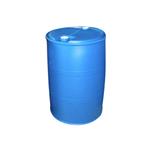 |
2024-04-19 | Mesitylene
108-67-8
|
US $2.00 / kg | 1kg | ≥99% | 1000mt/year | Jinan Finer Chemical Co., Ltd | |
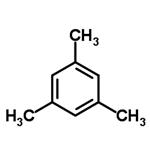 |
2023-09-15 | Mesitylene
108-67-8
|
US $0.00 / kg | 170kg | 98.0% | 1000t | Taixing Foreign Trade Nanjing Co., Ltd. | |
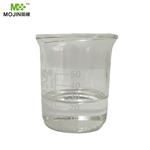 |
2023-06-27 | Mesitylene
108-67-8
|
US $0.00 / KG | 1KG | 99% | 50000KG/month | Hebei Mojin Biotechnology Co., Ltd |
-

- Mesitylene
108-67-8
- US $2.00 / kg
- ≥99%
- Jinan Finer Chemical Co., Ltd
-

- Mesitylene
108-67-8
- US $0.00 / kg
- 98.0%
- Taixing Foreign Trade Nanjing Co., Ltd.
-

- Mesitylene
108-67-8
- US $0.00 / KG
- 99%
- Hebei Mojin Biotechnology Co., Ltd
108-67-8(Mesitylene)Related Search:
1of4





